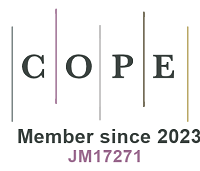REFERENCES
1. Plastics-the Facts. An analysis of European plastics production, demand and waste data. 2020. Available from: https://plasticseurope.org/knowledge-hub/plastics-the-facts-2020/ [Last accessed on 12 Jul 2022].
2. Shrivastava S, Shrivastava P. Strengthening of existing water treatment procedures to respond to the presence of microplastics in the drinking water. Int J Env Health Eng 2020;9:1.
3. Barceló D, Picó Y. Microplastics in the global aquatic environment: analysis, effects, remediation and policy solutions. J Environ Chem Eng 2019;7:103421.
4. Barcelo D, Pico Y. Case studies of macro- and microplastics pollution in coastal waters and rivers: Is there a solution with new removal technologies and policy actions? Case Stud Chem Environ Eng 2020;2:100019.
5. Smith E, Dziewatkoski M, Henrie T, Seidel C, Rosen J. Microplastics: what drinking water utilities need to know. J Am Water Works Assoc 2019;111:26-37.
6. Gomiero A, Øysæd KB, Palmas L, Skogerbø G. Application of GCMS-pyrolysis to estimate the levels of microplastics in a drinking water supply system. J Hazard Mater 2021;416:125708.
7. Picó Y, Soursou V, Alfarhan AH, El-Sheikh MA, Barceló D. First evidence of microplastics occurrence in mixed surface and treated wastewater from two major Saudi Arabian cities and assessment of their ecological risk. J Hazard Mater 2021;416:125747.
8. Picó Y, Alvarez-Ruiz R, Alfarhan AH, El-Sheikh MA, Alshahrani HO, Barceló D. Pharmaceuticals, pesticides, personal care products and microplastics contamination assessment of Al-Hassa irrigation network (Saudi Arabia) and its shallow lakes. Sci Total Environ 2020;701:135021.
9. Picó Y, Barceló D. Analysis and prevention of microplastics pollution in water: current perspectives and future directions. ACS Omega 2019;4:6709-19.
10. Koelmans AA, Mohamed Nor NH, Hermsen E, Kooi M, Mintenig SM, De France J. Microplastics in freshwaters and drinking water: critical review and assessment of data quality. Water Res 2019;155:410-22.
11. Li Y, Li W, Jarvis P, et al. Occurrence, removal and potential threats associated with microplastics in drinking water sources. J Environ Chem Eng 2020;8:104527.
12. Barchiesi M, Chiavola A, Di Marcantonio C, Boni MR. Presence and fate of microplastics in the water sources: focus on the role of wastewater and drinking water treatment plants. J Water Process Eng 2021;40:101787.
13. Eriksen M, Lebreton LC, Carson HS, et al. Plastic pollution in the world’s oceans: more than 5 trillion plastic pieces weighing over 250,000 tons afloat at sea. PLoS One 2014;9:e111913.
14. De-la-Torre GE, Dioses-Salinas DC, Pizarro-Ortega CI, et al. Binational survey of personal protective equipment (PPE) pollution driven by the COVID-19 pandemic in coastal environments: abundance, distribution, and analytical characterization. J Hazard Mater 2022;426:128070.
15. Hajiouni S, Mohammadi A, Ramavandi B, et al. Occurrence of microplastics and phthalate esters in urban runoff: a focus on the Persian Gulf coastline. Sci Total Environ 2022;806:150559.
16. Cheng YL, Kim J, Kim H, Choi JH, Fai Tsang Y, Baek K. Occurrence and removal of microplastics in wastewater treatment plants and drinking water purification facilities: a review. Chem Eng J 2021;410:128381.
17. Novotna K, Cermakova L, Pivokonska L, Cajthaml T, Pivokonsky M. Microplastics in drinking water treatment - current knowledge and research needs. Sci Total Environ 2019;667:730-40.
18. Prata JC, da Costa JP, Lopes I, Andrady AL, Duarte AC, Rocha-Santos T. A One Health perspective of the impacts of microplastics on animal, human and environmental health. Sci Total Environ 2021;777:146094.
19. Prata JC, da Costa JP, Lopes I, Duarte AC, Rocha-Santos T. Environmental exposure to microplastics: an overview on possible human health effects. Sci Total Environ 2020;702:134455.
20. Walkinshaw C, Lindeque PK, Thompson R, Tolhurst T, Cole M. Microplastics and seafood: lower trophic organisms at highest risk of contamination. Ecotoxicol Environ Saf 2020;190:110066.
21. Zhang Q, Xu EG, Li J, et al. A review of microplastics in table salt, drinking water, and air: direct human exposure. Environ Sci Technol 2020;54:3740-51.
22. Conti I, Simioni C, Varano G, Brenna C, Costanzi E, Neri LM. Legislation to limit the environmental plastic and microplastic pollution and their influence on human exposure. Environ Pollut 2021;288:117708.
24. Oladoja NA, Unuabonah IE. The pathways of microplastics contamination in raw and drinking water. J Water Process Eng 2021;41:102073.
25. Eerkes-medrano D, Leslie HA, Quinn B. Microplastics in drinking water: a review and assessment. Curr Opin Environ Sci Health 2019;7:69-75.
26. Ásmundsdóttir ÁM, Gomiero A, Øysæd KB. Microplastics and nanoplastics occurrence and composition in drinking water from Akureyri Urban Area, Iceland. Springer Water 2020. p. 106-11.
27. Sol D, Laca A, Laca A, Díaz M. Microplastics in wastewater and drinking water treatment plants: occurrence and removal of microfibres. Appl Sci 2021;11:10109.
28. Picó Y, Barceló D. Pyrolysis gas chromatography-mass spectrometry in environmental analysis: focus on organic matter and microplastics. TrAC Trends Anal Chem 2020;130:115964.
29. Pico Y, Alfarhan A, Barcelo D. Nano- and microplastic analysis: focus on their occurrence in freshwater ecosystems and remediation technologies. TrAC Trends Anal Chem 2019;113:409-25.
30. Elkhatib D, Oyanedel-Craver V. A critical review of extraction and identification methods of microplastics in wastewater and drinking water. Environ Sci Technol 2020;54:7037-49.
31. Praveena SM, Laohaprapanon S. Quality assessment for methodological aspects of microplastics analysis in bottled water - a critical review. Food Control 2021;130:108285.
32. Schymanski D, Oßmann BE, Benismail N, et al. Analysis of microplastics in drinking water and other clean water samples with micro-Raman and micro-infrared spectroscopy: minimum requirements and best practice guidelines. Anal Bioanal Chem 2021;413:5969-94.
33. Di M, Liu X, Wang W, Wang J. Corrigendum to “Pollution in drinking water source areas: Microplastics in the Danjiangkou Reservoir, China” [Environ. Toxicol. Pharmacol. 65 (January) 2019 82-89]. Environ Toxicol Pharmacol 2019;66:133.
34. Zuccarello P, Ferrante M, Cristaldi A, et al. Reply for comment on “Exposure to microplastics (< 10 μm) associated to plastic bottles mineral water consumption: the first quantitative study by Zuccarello et al. [Water Research 157 (2019) 365-371]”. Water Res 2019;166:115077.
35. Oßmann B, Schymanski D, Ivleva NP, et al. Comment on “exposure to microplastics (< 10 μm) associated to plastic bottles mineral water consumption: the first quantitative study by Zuccarello et al. [Water Research 157 (2019) 365-371]”. Water Res 2019;162:516-7.
36. Xue J, Samaei SH, Chen J, Doucet A, Ng KTW. What have we known so far about microplastics in drinking water treatment? Front Environ Sci Eng 2022;16:58.
37. Shen M, Song B, Zhu Y, et al. Removal of microplastics via drinking water treatment: current knowledge and future directions. Chemosphere 2020;251:126612.
38. Ding H, Zhang J, He H, et al. Do membrane filtration systems in drinking water treatment plants release nano/microplastics? Sci Total Environ 2021;755:142658.
39. Xu Y, He Q, Liu C, Huangfu X. Are micro- or nanoplastics leached from drinking water distribution systems? Environ Sci Technol 2019;53:9339-40.
40. Hogue C. POLLUTION Microplastics in drinking water not risky. chemical & engineering news. Chem Eng News 2019;97:22. Available online: https://www.cheric.org/research/tech/periodicals/view.php?seq=1758887 [Last accessed on 12 Jul 2022].
41. Mortensen NP, Fennell TR, Johnson LM. Unintended human ingestion of nanoplastics and small microplastics through drinking water, beverages, and food sources. NanoImpact 2021;21:100302.
42. Hohmann-Jeddi C. Microplastics in drinking water: WHO calls for more research on risks. Pharmazeutische Zeitung. 2019;164:46. Available online: https://www.pharmazeutische-zeitung.de/who-fordert-mehr-forschung-zu-risiken/ [Last accessed on 12 Jul 2022].
43. Adib D, Mafigholami R, Tabeshkia H. Identification of microplastics in conventional drinking water treatment plants in Tehran, Iran. J Environ Health Sci Eng 2021;19:1817-26.
44. Almaiman L, Aljomah A, Bineid M, et al. The occurrence and dietary intake related to the presence of microplastics in drinking water in Saudi Arabia. Environ Monit Assess 2021;193:390.
45. Chanpiwat P, Damrongsiri S. Abundance and characteristics of microplastics in freshwater and treated tap water in Bangkok, Thailand. Environ Monit Assess 2021;193:258.
46. Cherniak SL, Almuhtaram H, McKie MJ, et al. Conventional and biological treatment for the removal of microplastics from drinking water. Chemosphere 2022;288:132587.
47. Dalmau-Soler J, Ballesteros-Cano R, Boleda MR, Paraira M, Ferrer N, Lacorte S. Microplastics from headwaters to tap water: occurrence and removal in a drinking water treatment plant in Barcelona Metropolitan area (Catalonia, NE Spain). Environ Sci Pollut Res Int 2021;28:59462-72.
48. Dalmau-soler J, Ballesteros-cano R, Ferrer N, Boleda MR, Lacorte S. Microplastics throughout a tap water supply network. Water Environ J 2022;36:292-8.
49. Di M, Liu X, Wang W, Wang J. Manuscript prepared for submission to environmental toxicology and pharmacology pollution in drinking water source areas: Microplastics in the Danjiangkou Reservoir, China. Environ Toxicol Pharmacol 2019;65:82-9.
50. Huang S, Peng C, Wang Z, et al. Spatiotemporal distribution of microplastics in surface water, biofilms, and sediments in the world’s largest drinking water diversion project. Sci Total Environ 2021;789:148001.
51. Ibeto C, Enyoh C, Ofomatah A, Oguejiofor L, Okafocha T, Okanya V. Microplastics pollution indices of bottled water from South Eastern Nigeria. Intern J Environ Anal Chem 2021.
53. Lee EH, Lee S, Chang Y, Lee SW. Simple screening of microplastics in bottled waters and environmental freshwaters using a novel fluorophore. Chemosphere 2021;285:131406.
54. Li Y, Wang Z, Guan B. Separation and identification of nanoplastics in tap water. Environ Res 2022;204:112134.
55. Mintenig SM, Löder MGJ, Primpke S, Gerdts G. Low numbers of microplastics detected in drinking water from ground water sources. Sci Total Environ 2019;648:631-5.
56. Mukotaka A, Kataoka T, Nihei Y. Rapid analytical method for characterization and quantification of microplastics in tap water using a Fourier-transform infrared microscope. Sci Total Environ 2021;790:148231.
57. Oßmann BE, Sarau G, Holtmannspötter H, Pischetsrieder M, Christiansen SH, Dicke W. Small-sized microplastics and pigmented particles in bottled mineral water. Water Res 2018;141:307-16.
58. Paredes M, Castillo T, Viteri R, Fuentes G, Bodero E. Microplastics in the drinking water of the Riobamba city, Ecuador. srees 2021;28:653-63.
59. Pivokonský M, Pivokonská L, Novotná K, Čermáková L, Klimtová M. Occurrence and fate of microplastics at two different drinking water treatment plants within a river catchment. Sci Total Environ 2020;741:140236.
60. Pivokonsky M, Cermakova L, Novotna K, Peer P, Cajthaml T, Janda V. Occurrence of microplastics in raw and treated drinking water. Sci Total Environ 2018;643:1644-51.
61. Sarkar DJ, Das Sarkar S, Das BK, et al. Microplastics removal efficiency of drinking water treatment plant with pulse clarifier. J Hazard Mater 2021;413:125347.
62. Scircle A, Cizdziel JV. Detecting and quantifying microplastics in bottled water using fluorescence microscopy: a new experiment for instrumental analysis and environmental chemistry courses. J Chem Educ 2020;97:234-8.
63. Shen M, Zeng Z, Wen X, et al. Presence of microplastics in drinking water from freshwater sources: the investigation in Changsha, China. Environ Sci Pollut Res Int 2021;28:42313-24.
64. Shruti VC, Pérez-Guevara F, Kutralam-Muniasamy G. Metro station free drinking water fountain- a potential “microplastics hotspot” for human consumption. Environ Pollut 2020;261:114227.
65. Singh T. Generation of microplastics from the opening and closing of disposable plastic water bottles. J Water Health 2021;19:488-98.
66. Tong H, Jiang Q, Hu X, Zhong X. Occurrence and identification of microplastics in tap water from China. Chemosphere 2020;252:126493.
67. Wang Z, Lin T, Chen W. Occurrence and removal of microplastics in an advanced drinking water treatment plant (ADWTP). Sci Total Environ 2020;700:134520.
68. Weber F, Kerpen J, Wolff S, Langer R, Eschweiler V. Investigation of microplastics contamination in drinking water of a German city. Sci Total Environ 2021;755:143421.
69. Weisser J, Beer I, Hufnagl B, et al. From the well to the bottle: identifying sources of microplastics in mineral water. Water 2021;13:841.
70. Wu J, Zhang Y, Tang Y. Fragmentation of microplastics in the drinking water treatment process - a case study in Yangtze River region, China. Sci Total Environ 2022;806:150545.
71. Zhang M, Li J, Ding H, et al. Distribution characteristics and influencing factors of microplastics in urban tap water and water sources in Qingdao, China. Analytical Letters 2020;53:1312-27.
72. Zuccarello P, Ferrante M, Cristaldi A, et al. Exposure to microplastics (< 10 μm) associated to plastic bottles mineral water consumption: the first quantitative study. Water Res 2019;157:365-71.
73. Shao Y, Zhou X, Liu X, Wang L. Pre-oxidization-induced change of physicochemical characteristics and removal behaviours in conventional drinking water treatment processes for polyethylene microplastics. RSC Adv 2020;10:41488-94.







